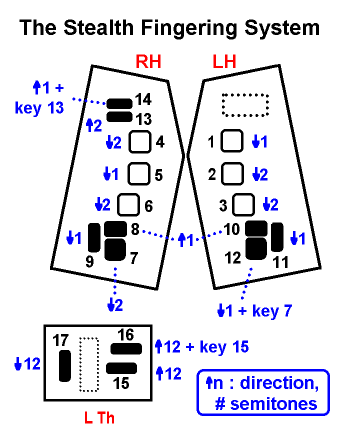The Stealth Fingering System
 This figure shows the layout of the keys and their functions. The right hand (RH) and left hand (LH) finger keys are shown from the front of the instrument, the left hand thumb (L Th) keys from the rear. Each key is labeled by a key number (1-17). Also shown is the musical interval, in semitones, produced by actuating each key. The arrows indicate whether the pitch is shifted up or down. The hands are placed so that the index fingers are on keys 1 and 4. Note that if keys 1-7 are actuated sequentially, a descending major scale is produced.
This figure shows the layout of the keys and their functions. The right hand (RH) and left hand (LH) finger keys are shown from the front of the instrument, the left hand thumb (L Th) keys from the rear. Each key is labeled by a key number (1-17). Also shown is the musical interval, in semitones, produced by actuating each key. The arrows indicate whether the pitch is shifted up or down. The hands are placed so that the index fingers are on keys 1 and 4. Note that if keys 1-7 are actuated sequentially, a descending major scale is produced.
Three of the keys have a "compound" action: they produce an interval on their own, but at the same time they also actuate another key. An example is key 12, which shifts the pitch down a semitone and also actuates key 7, which shifts the pitch down a whole tone. If key 7 is not already actuated, then actuating key 12 shifts the pitch down 3 semitones. If key 7 is already actuated, then key 12 shifts the pitch down one semitone. This action is similar to the low b/e keys on clarinet, which have mechanical linkages to the c/f keys.
Back Home
 This figure shows the layout of the keys and their functions. The right hand (RH) and left hand (LH) finger keys are shown from the front of the instrument, the left hand thumb (L Th) keys from the rear. Each key is labeled by a key number (1-17). Also shown is the musical interval, in semitones, produced by actuating each key. The arrows indicate whether the pitch is shifted up or down. The hands are placed so that the index fingers are on keys 1 and 4. Note that if keys 1-7 are actuated sequentially, a descending major scale is produced.
This figure shows the layout of the keys and their functions. The right hand (RH) and left hand (LH) finger keys are shown from the front of the instrument, the left hand thumb (L Th) keys from the rear. Each key is labeled by a key number (1-17). Also shown is the musical interval, in semitones, produced by actuating each key. The arrows indicate whether the pitch is shifted up or down. The hands are placed so that the index fingers are on keys 1 and 4. Note that if keys 1-7 are actuated sequentially, a descending major scale is produced.